Microgrid Optimal Dispatch Based on Distributed Economic Model Predictive Control Algorithm
Abstract
:1. Introduction
- (1)
- Multi-node collaboration can make full use of the information and arithmetic power of each node to improve the prediction accuracy.
- (2)
- Due to multi-node collaboration, the system is more fault-tolerant and will not cause the failure of the whole system due to the failure or collapse of a single node, which enhances the robustness of economic control.
- (3)
- Since the data are dispersed in different nodes, it can avoid some risks associated with the centralized storage and transmission of sensitive data and protect privacy and security.
2. Microgrid System Description
2.1. Mathematical Model of Wind Turbine Electronic System
2.2. Mathematical Model of Photovoltaic Power Generation System
2.3. Mathematical Model of Battery Energy Storage System
3. Optimal Dispatching Model of Microgrid Group
3.1. Optimization Objectives
3.2. Constraint Conditions
4. Distributed Economic Model Predictive Controller
4.1. Controller Design
4.2. Control Quantity Solving Algorithm
- Initialization: At the initial time , the feasible control input quantity and corresponding state quantity of subsystem are initialized, and give the prediction time domain and control time domain . The iteration number is set to so that the control quantity, state quantity and output quantity of the $flag$ iteration of subsystem at the initial time are , and , respectively, in order to transfer the information of each subsystem to other subsystems;
- cycle calculation:
- (1)
- Subsystem i receives its neighbor’s information and encapsulates it as , and ;
- (2)
- The optimization problem (26) is solved, and the solution is obtained under this iteration;
- (3)
- Whether the optimization solution meets the iteration termination conditions is checked, that is, given the accuracy , whether it meets the requirements or whether the number of iterations exceeds the set maximum number of iterations, , is checked. If the optimization solution satisfies the iteration termination condition, the iteration ends. The solution obtained by the controller of subsystem in this iteration optimization calculation is the Nash optimal solution at time , that is, . At this point, the algorithm proceeds to step (3); otherwise, ;
- (4)
- According to the solution calculated in this iteration, the corresponding state quantity and output quantity are obtained, and the information is transferred to other subsystems except for subsystem i. Subsystem is updated as per , and , and step 2 is repeated.
- The optimal control law is applied to the corresponding subsystem;
- Let , upon which the algorithm scrolls to the next moment, resets the iteration number $flag$ to zero and transfers the optimization solution of each subsystem at the previous moment, as well as the corresponding state quantity and output quantity to other subsystems as the estimated information. The algorithm returns to step 2 and repeats the above process.
5. Simulation Example
6. Conclusions
Author Contributions
Funding
Institutional Review Board Statement
Informed Consent Statement
Conflicts of Interest
References
- Rocabert, J.; Luna, A.; Blaabjerg, F.; Rodríguez, P. Control of Power Converters in AC Microgrids. IEEE Trans. Power Electron. 2012, 27, 4734–4749. [Google Scholar] [CrossRef]
- Pogaku, N.; Prodanovic, M.; Green, T.C. Modeling, Analysis and Testing of Autonomous Operation of an Inverter-Based Microgrid. IEEE Trans. Power Electron. 2007, 22, 613–625. [Google Scholar] [CrossRef] [Green Version]
- Tiwari, S.; Ongsakul, W.; Singh, J.G. Design and Simulation of an Islanded Hybrid Microgrid for Remote Off-Grid Communities. In Proceedings of the 2020 International Conference and Utility Exhibition on Energy, Environment and Climate Change (ICUE), Pattaya, Thailand, 20–22 October 2020; pp. 1–7. [Google Scholar] [CrossRef]
- Olivares, D.E.; Mehrizi-Sani, A.; Etemadi, A.H.; Canizares, C.A.; Iravani, R.; Kazerani, M.; Hajimiragha, A.H.; Gomis-Bellmunt, O.; Saeedifard, M.; Palma-Behnke, R.; et al. Trends in Microgrid Control. IEEE Trans. Smart Grid 2014, 5, 1905–1919. [Google Scholar] [CrossRef]
- Bidram, A.; Davoudi, A. Hierarchical Structure of Microgrids Control System. IEEE Trans. Smart Grid 2012, 3, 1963–1976. [Google Scholar] [CrossRef]
- Shin, Y.; Park, W.; Lee, I. Design of microgrid web services for microgrid applications. In Proceedings of the 2017 Ninth International Conference on Ubiquitous and Future Networks (ICUFN), Milan, Italy, 4–7 July 2017; pp. 818–822. [Google Scholar] [CrossRef]
- Bai, B.; Wang, K.; Bu, L.; Liu, S.; Cheng, M.; Yue, C. Feasibility Evaluation for a Multi-Energy Microgrid Case Study in China. In Proceedings of the 2019 IEEE PES Asia-Pacific Power and Energy Engineering Conference (APPEEC), Macao, China, 1–4 December 2019; pp. 1–5. [Google Scholar] [CrossRef]
- Saldarriaga-Zuluaga, S.D.; Lopez-Lezama, J.M.; Muñoz-Galeano, N. Protection Coordination in Microgrids: Current Weaknesses, Available Solutions and Future Challenges. IEEE Lat. Am. Trans. 2020, 18, 1715–1723. [Google Scholar] [CrossRef]
- Jones, C.B.; Vining, W.F.; Haines, T. Current & Future Photovoltaic System Impacts on City-Wide Grid Performance & Neighborhood Microgrids. In Proceedings of the 2022 IEEE 49th Photovoltaics Specialists Conference (PVSC), Philadelphia, PA, USA, 5–10 June 2022; pp. 0276–0282. [Google Scholar] [CrossRef]
- Li, Y.; Ma, W.; Zhang, Z.; Niu, G.; Wu, M.; Weng, Y. Energy Efficiency Evaluation of Multi-Energy Microgrid Based on Entropy-Independence-Gl Method. In Proceedings of the 2022 IEEE 5th International Electrical and Energy Conference (CIEEC), Nangjing, China, 27–29 May 2022; pp. 2232–2237. [Google Scholar] [CrossRef]
- Xiao, J.; Zhao, T.; Hai, K.L.; Wang, P. Smart energy hub—Modularized hybrid AC/DC microgrid: System design and deployment. In Proceedings of the 2017 IEEE Conference on Energy Internet and Energy System Integration (EI2), Beijing, China, 26–28 November 2017; pp. 1–6. [Google Scholar] [CrossRef]
- Parhizi, S.; Lotfi, H.; Khodaei, A.; Bahramirad, S. State of the Art in Research on Microgrids: A Review. IEEE Access 2015, 3, 890–925. [Google Scholar] [CrossRef]
- Chen, S.X.; Gooi, H.B.; Wang, M.Q. Sizing of Energy Storage for Microgrids. IEEE Trans. Smart Grid 2012, 3, 142–151. [Google Scholar] [CrossRef]
- Ishraque, M.F.; Ali, M.M. Optimized Design of a Hybrid Microgrid using Renewable Resources Considering Different Dispatch Strategies. In Proceedings of the 2021 International Conference on Automation, Control and Mechatronics for Industry 4.0 (ACMI), Rajshahi, Bangladesh, 8–9 July 2021; pp. 1–6. [Google Scholar] [CrossRef]
- Headley, A.J.; Schenkman, B.L.; Rosewater, D.M. Discrete Logic vs Optimized Dispatch for Energy Storage in a Microgrid. In Proceedings of the 2020 IEEE Power & Energy Society General Meeting (PESGM), Montreal, QC, Canada, 2–6 August 2020; pp. 1–5. [Google Scholar] [CrossRef]
- Yin, T.; Du, C.; Chen, A.; Jiang, T.; Guo, S.; Zhang, H. Improved Genetic Algorithm-Based Optimization Approach for Energy Management of Microgrid. In Proceedings of the 2020 IEEE 9th International Power Electronics and Motion Control Conference (IPEMC2020-ECCE Asia), Nanjing, China, 29 November–2 December 2020; pp. 3234–3239. [Google Scholar] [CrossRef]
- Ignat, A.; Lazar, E.; Petreus, D. Energy Management for an Islanded Microgrid Based on Particle Swarm Optimization. In Proceedings of the IEEE 24th International Symposium for Design and Technology in Electronic Packaging (SIITME), Iasi, Romania, 25–28 October 2018; pp. 213–216. [Google Scholar] [CrossRef]
- Devlin, D.; O’Sullivan, B. Preferential Attachment in Constraint Networks. In Proceedings of the 2009 21st IEEE International Conference on Tools with Artificial Intelligence, Newark, NJ, USA, 2–4 November 2009; pp. 708–715. [Google Scholar] [CrossRef]
- Ortmeyer, T.; Wu, L.; Li, J. Planning and design goals for resilient microgrids. In Proceedings of the 2016 IEEE Power & Energy Society Innovative Smart Grid Technologies Conference (ISGT), Minneapolis, MN, 9–12 October 2016; pp. 1–5. [Google Scholar] [CrossRef]
- Dalai, S.K.; Prince, S.K.; Abhishek, A.; Affijulla, S.; Panda, G. Power Management Strategies for Islanding and Grid-Connected DC Microgrid Systems with Multiple Renewable Energy Resources. In Proceedings of the 2022 IEEE Global Conference on Computing, Power and Communication Technologies (GlobConPT), New Delhi, India, 23–25 September 2022; pp. 1–6. [Google Scholar] [CrossRef]
- Navas-Fonseca, A.; Burgos-Mellado, C.; Espina, E.; Rute, E.; Gomez, J.S.; Saez, D.; Sumner, M. Distributed Predictive Secondary Control for Voltage Restoration and Economic Dispatch of Generation for DC Microgrids. In Proceedings of the 2021 IEEE Fourth International Conference on DC Microgrids (ICDCM), Arlington, VA, USA, 18–21 July 2021; pp. 1–6. [Google Scholar] [CrossRef]
- Zheng, X.; Li, H.; Chen, X.; Min, Z. Three-level microgrid inverter optimization algorithm based on model prediction control. In Proceedings of the IECON 2022—48th Annual Conference of the IEEE Industrial Electronics Society, Brussels, Belgium, 18–21 October 2022; pp. 1–6. [Google Scholar] [CrossRef]
- Selim, F.; Megahed, T.F.; Aly, M.; Shoyama, M.; Abdelkader, S.M. Model Predictive Control Based Improved Techno-Economic Control Strategy for Photovoltaic-Battery Microgrids. In Proceedings of the 2022 11th International Conference on Renewable Energy Research and Application (ICRERA), Istanbul, Turkey, 18–21 September 2022; pp. 230–235. [Google Scholar] [CrossRef]
- Yu, J.; Jin, H.; Zhang, Y.; Liu, C.; Xiao, L. A Two-stage Model Predictive Control Strategy for Economical Operation of Microgrid. In Proceedings of the 2020 15th IEEE Conference on Industrial Electronics and Applications (ICIEA), Kristiansand, Norway, 9–13 November 2020; pp. 882–887. [Google Scholar] [CrossRef]
- Guan, Y.; Vasquez, J.C.; Guerrero, J.M. Hierarchical controlled grid-connected microgrid based on a novel autonomous current sharing controller. In Proceedings of the 2015 IEEE Energy Conversion Congress and Exposition (ECCE), Montreal, QC, Canada, 20–24 September 2015; pp. 2333–2340. [Google Scholar] [CrossRef] [Green Version]
- Meng, L.; Savaghebi, M.; Andrade, F.; Vasquez, J.C.; Guerrero, J.M.; Graells, M. Microgrid central controller development and hierarchical control implementation in the intelligent microgrid lab of Aalborg University. In Proceedings of the 2015 IEEE Applied Power Electronics Conference and Exposition (APEC), Charlotte, NC, USA, 15–19 March 2015; pp. 2585–2592. [Google Scholar] [CrossRef] [Green Version]
- Muchande, S.; Thale, S. Design and Implementation of Autonomous Low Voltage DC Microgrid with Hierarchical Control. In Proceedings of the 2020 IEEE First International Conference on Smart Technologies for Power, Energy and Control (STPEC), Nagpur, India, 25–26 September 2020; pp. 1–6. [Google Scholar] [CrossRef]
- Farooq, U.; Yang, F.; Jun, Y.; Hassan, M.A.S.; Faiz, N.; Riaz, M.T.; Jinxian, L.; Shaikh, J.A. A Reliable Approach to Protect and Control of Wind Solar Hybrid DC Microgrids. In Proceedings of the 2019 IEEE 3rd Conference on Energy Internet and Energy System Integration (EI2), Changsha, China, 8–10 November 2019; pp. 348–353. [Google Scholar] [CrossRef]
- Prasanna, U.R.; Rajashekara, K. Fuel cell based hybrid power generation strategies for microgrid applications. In Proceedings of the 2015 IEEE Industry Applications Society Annual Meeting, Addison, TX, USA, 18–22 October 2015; pp. 1–7. [Google Scholar] [CrossRef]
- Liu, H.; Xie, X.; He, J.; Xu, T.; Yu, Z.; Wang, C.; Zhang, C. Subsynchronous Interaction Between Direct-Drive PMSG Based Wind Farms and Weak AC Networks. IEEE Trans. Power Syst. 2017, 32, 4708–4720. [Google Scholar] [CrossRef]
- He, L.; Wei, Z.; Yan, H.; Xv, K.-Y.; Zhao, M.-Y.; Cheng, S. A Day-ahead Scheduling Optimization Model of Multi-Microgrid Considering Interactive Power Control. In Proceedings of the 2019 4th International Conference on Intelligent Green Building and Smart Grid (IGBSG), Yichang, China, 6–9 September 2019; pp. 666–669. [Google Scholar] [CrossRef]
- Picioroaga, I.I.; Tudose, A.; Sidea, D.O.; Bulac, C.; Eremia, M. Two-level Scheduling Optimization of Multi-microgrids Operation in Smart Distribution Networks. In Proceedings of the 2020 International Conference and Exposition on Electrical and Power Engineering (EPE), Iasi, Romania, 22–23 October 2020; pp. 407–412. [Google Scholar] [CrossRef]
- Huo, Z.-H.; Wang, P.; Zhang, S.-J.; Wang, D.; Kong, Z. A Two-Step Multi-objective Optimization Frame-work for Microgrid Scheduling Problem Based on Cloud-edge Computing. In Proceedings of the 2020 IEEE 4th Conference on Energy Internet and Energy System Integration (EI2), Wuhan, China, 30 October–1 November 2020; pp. 2764–2768. [Google Scholar] [CrossRef]
- Li, B.; Wang, J.; Xia, N. Dynamic Optimal Scheduling of Microgrid Based on ε constraint multi-objective Biogeography-based Optimization Algorithm. In Proceedings of the 2020 5th International Conference on Automation, Control and Robotics Engineering (CACRE), Dalian, China, 19–20 September 2020; pp. 389–393. [Google Scholar] [CrossRef]
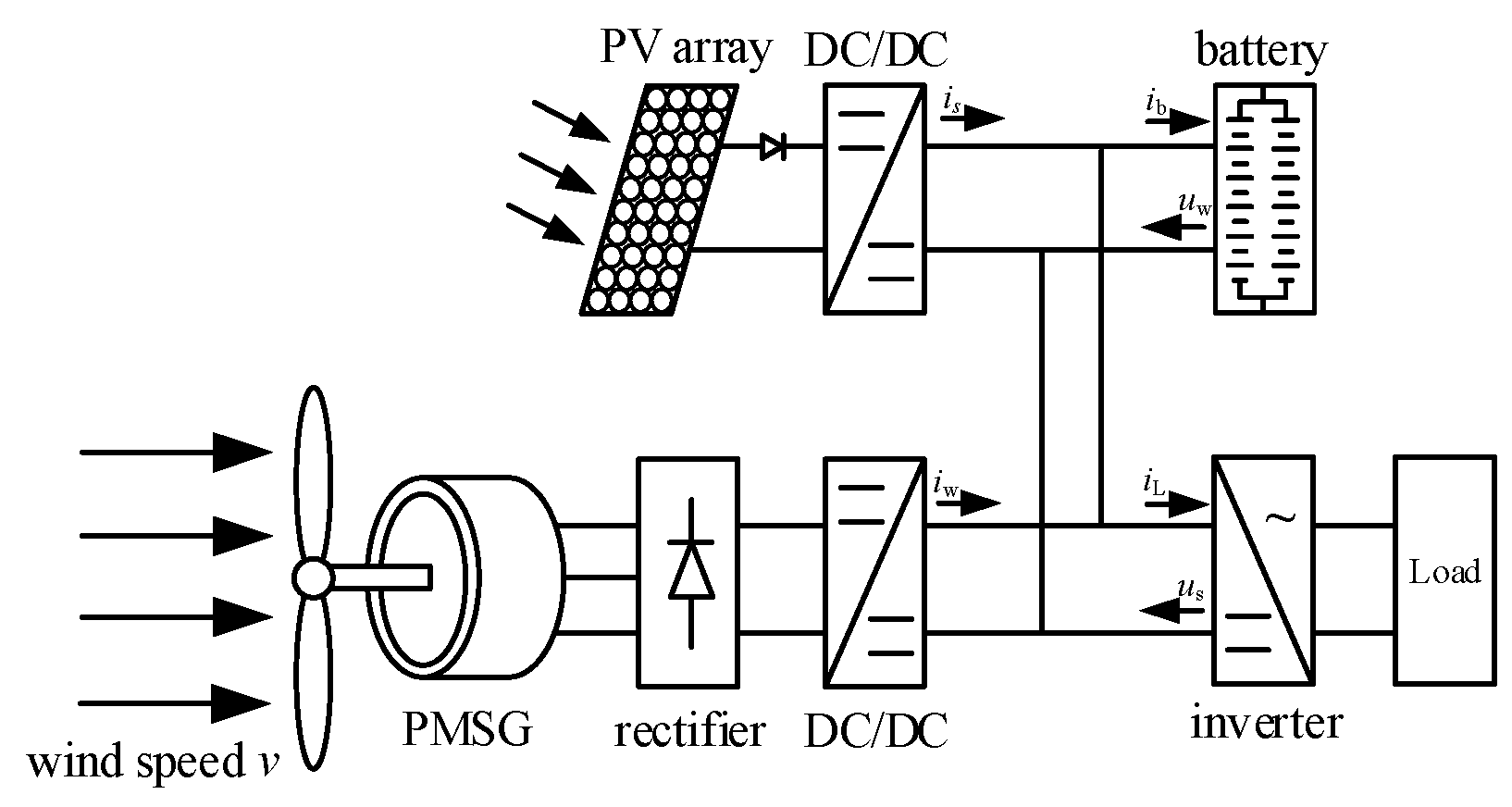
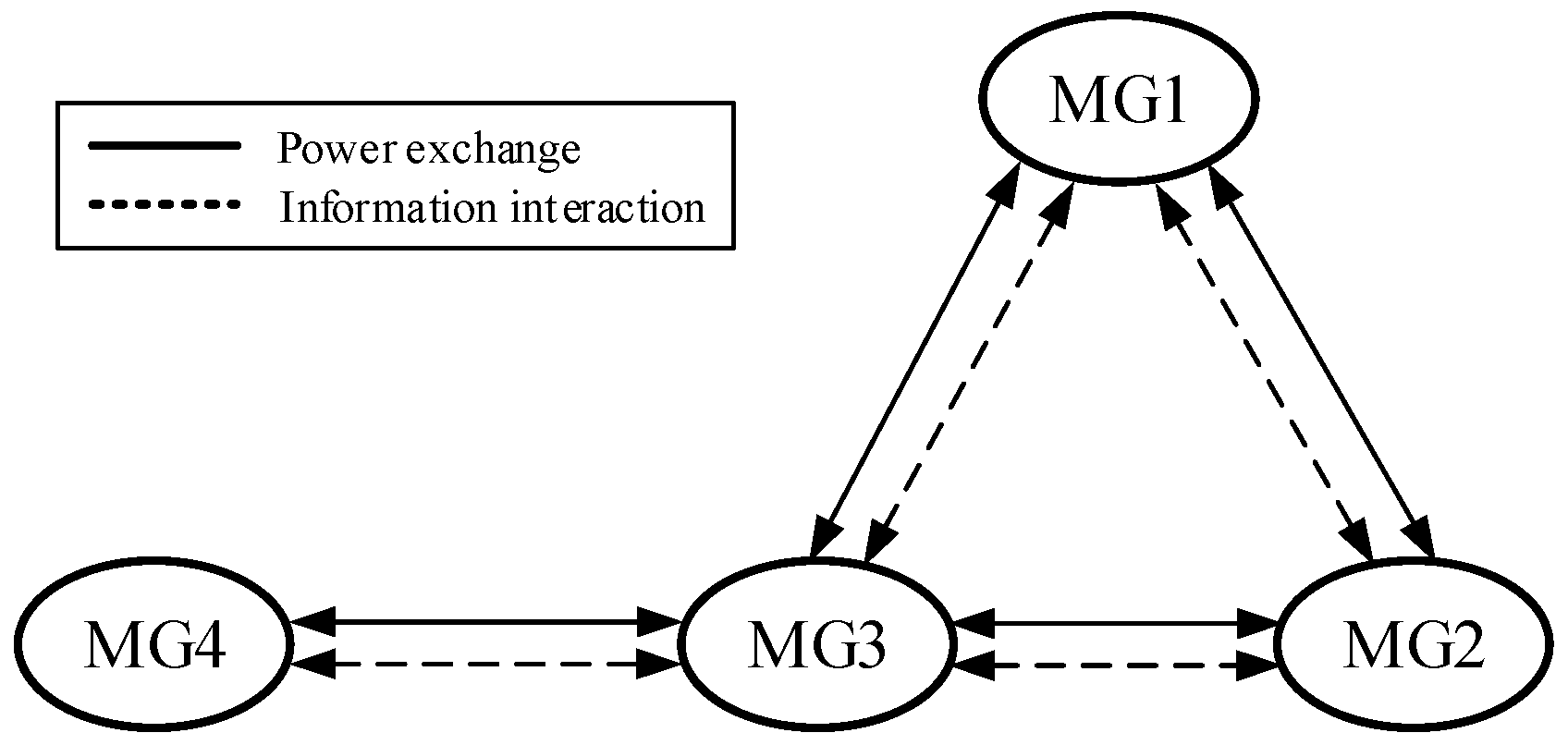

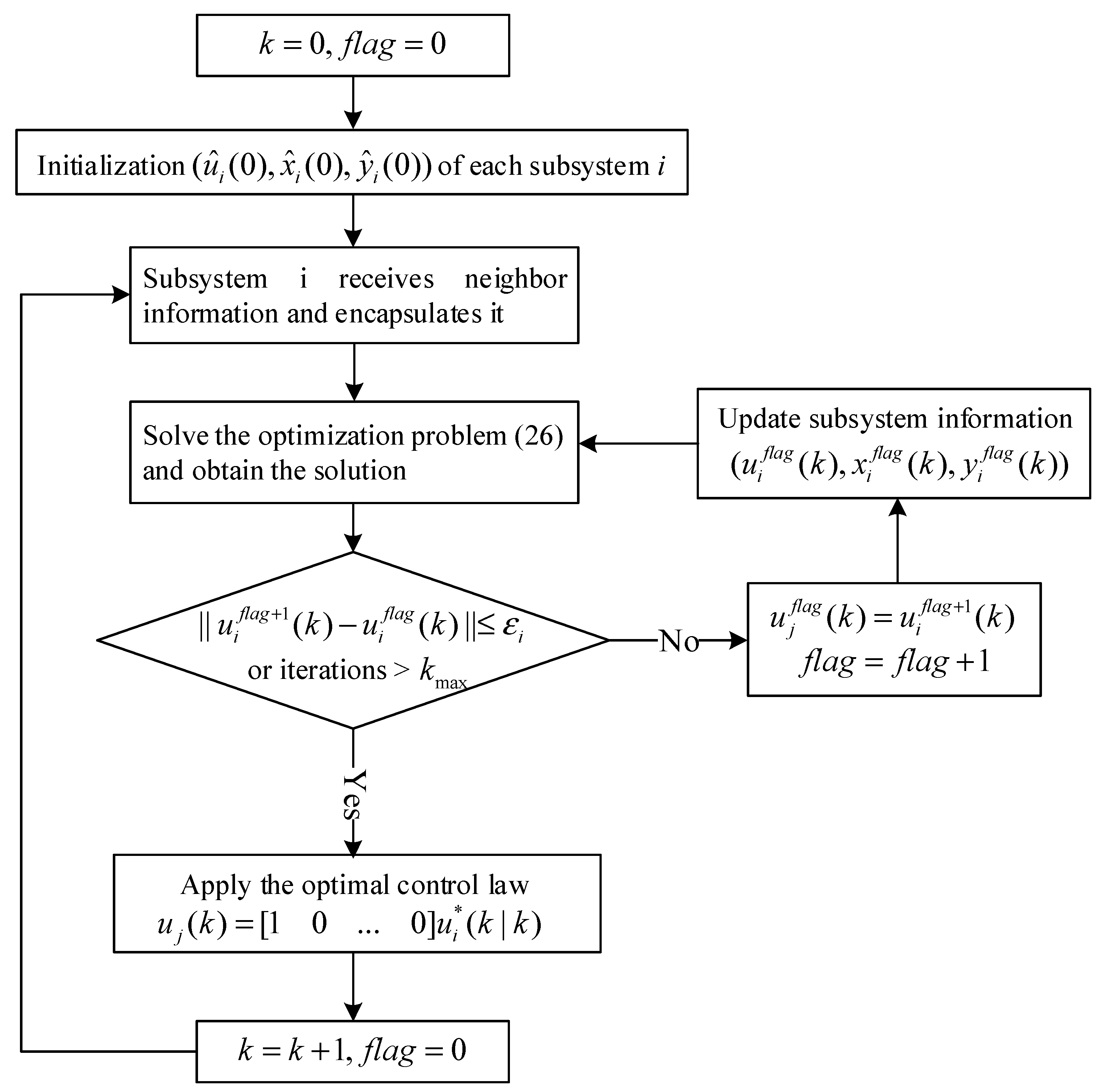

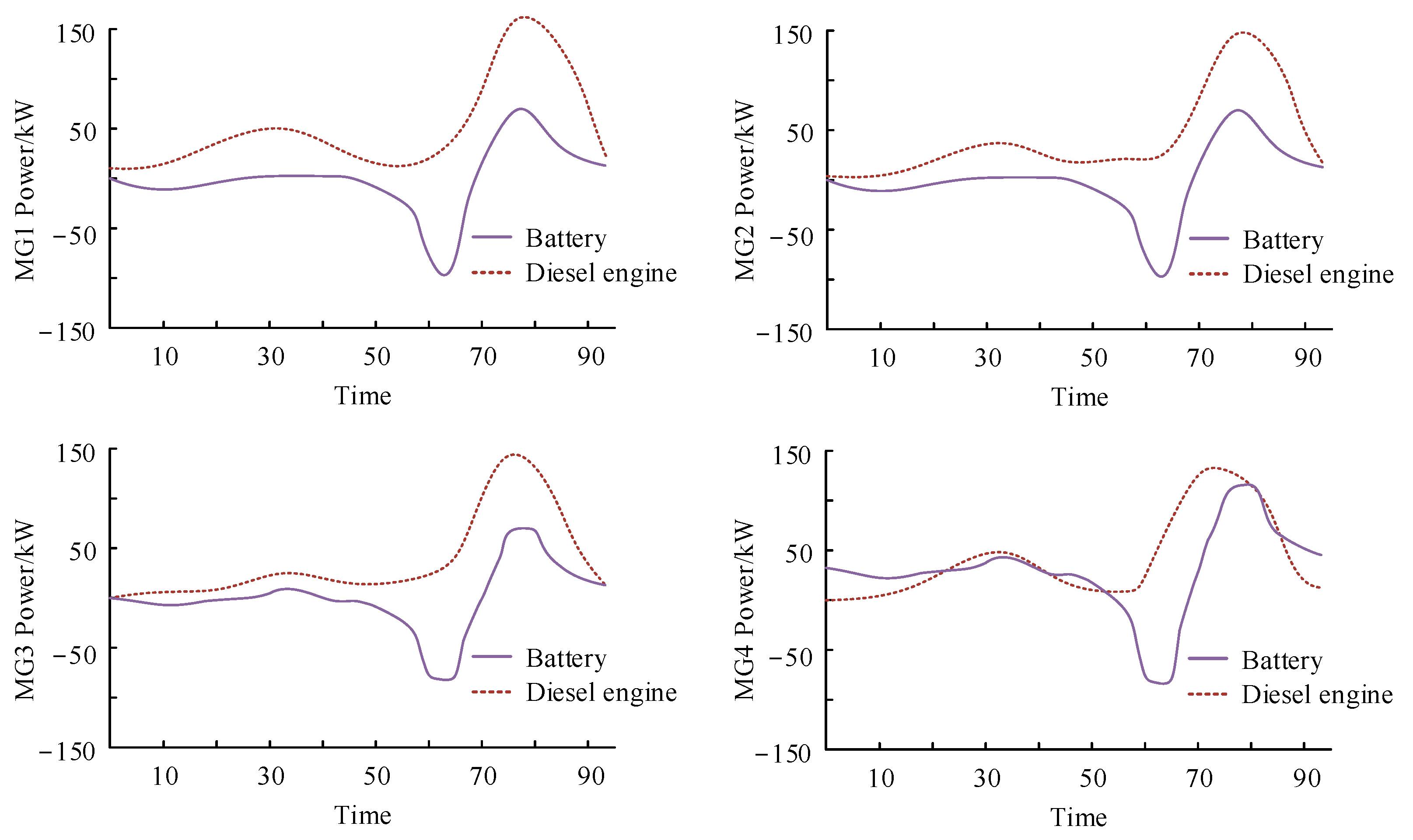
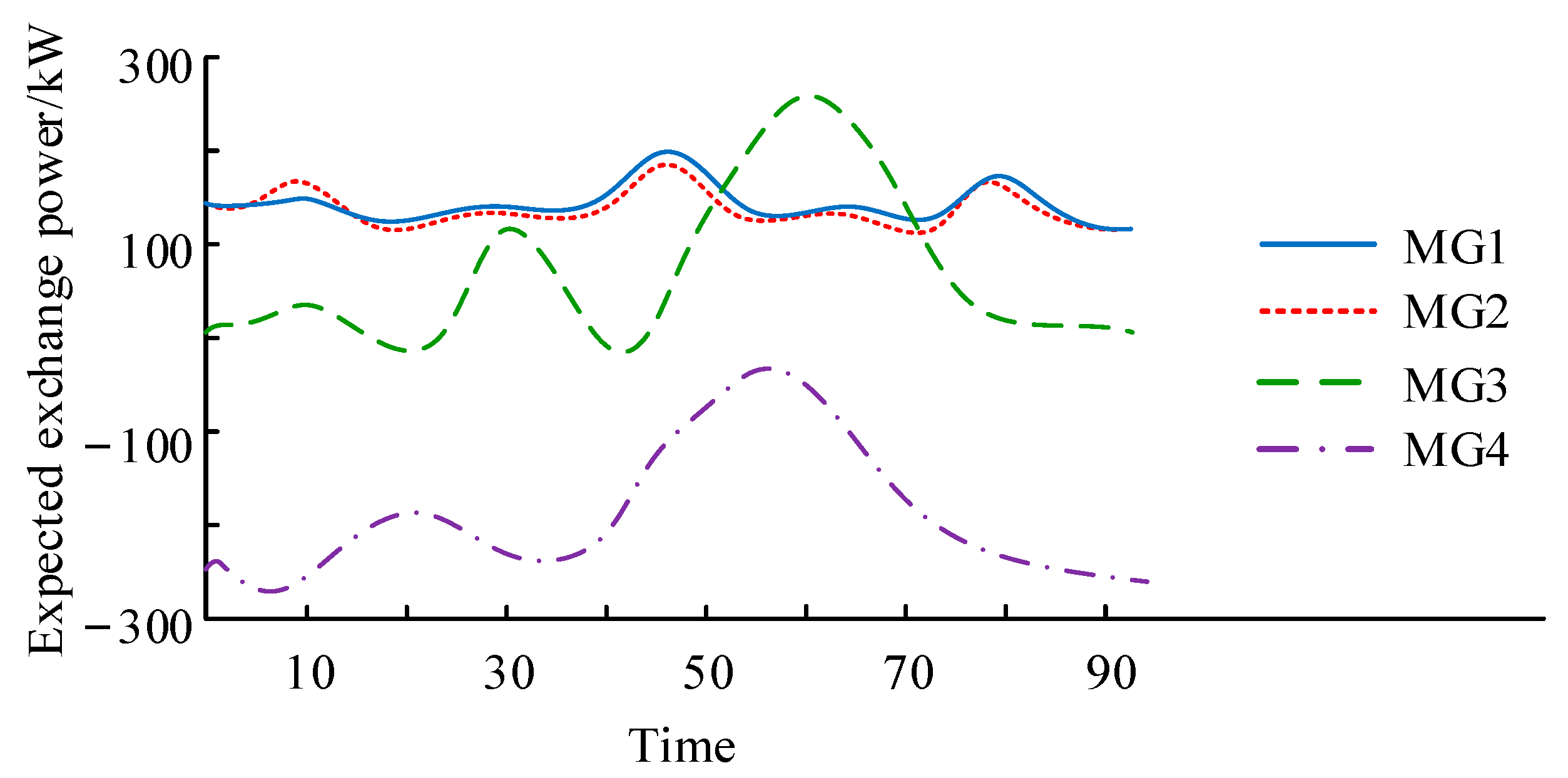


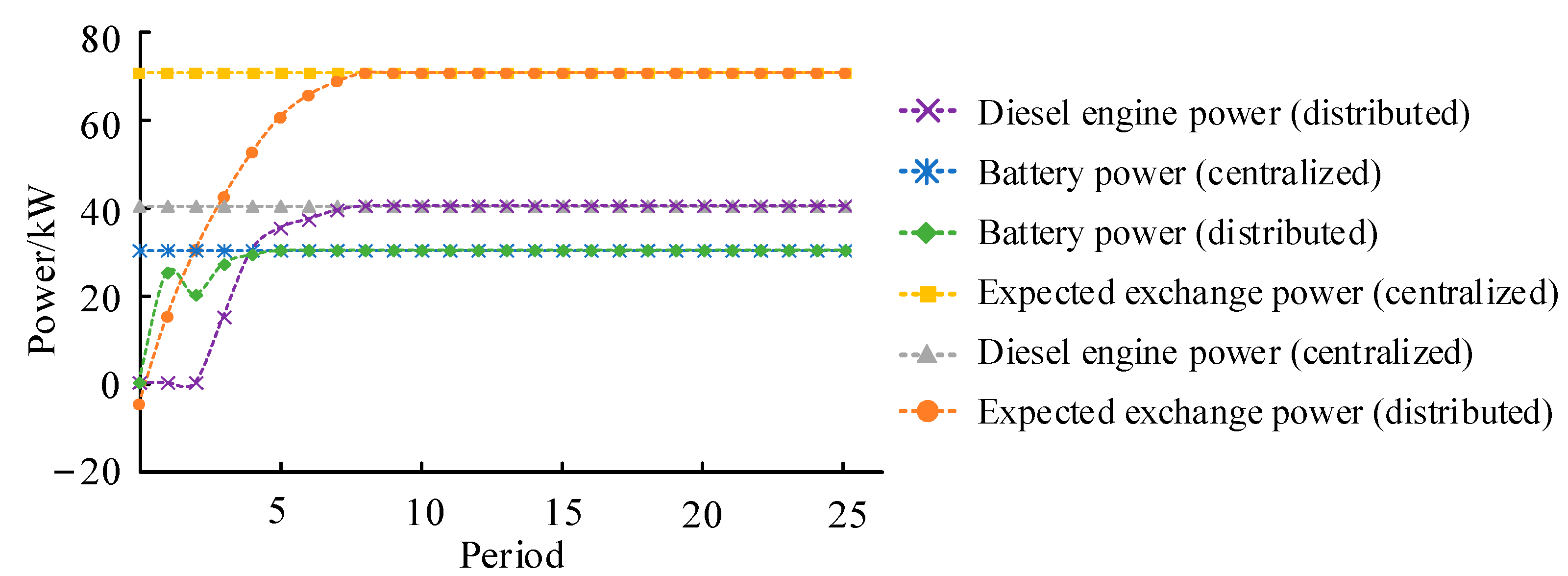
| Microgrid | Photovoltaic Rated Power/kW | Fan Rated Power/kW | Diesel Engine Rated Power/kW | Battery Rated Power/kW, Rated Capacity (kW·h) |
|---|---|---|---|---|
| MG1 | 350 | 600 | 300 | 200,800 |
| MG2 | 450 | 650 | 300 | 230,900 |
| MG3 | 800 | — | 400 | 230,100 |
| MG4 | 350 | 550 | 250 | 200,800 |
Disclaimer/Publisher’s Note: The statements, opinions and data contained in all publications are solely those of the individual author(s) and contributor(s) and not of MDPI and/or the editor(s). MDPI and/or the editor(s) disclaim responsibility for any injury to people or property resulting from any ideas, methods, instructions or products referred to in the content. |
© 2023 by the authors. Licensee MDPI, Basel, Switzerland. This article is an open access article distributed under the terms and conditions of the Creative Commons Attribution (CC BY) license (https://creativecommons.org/licenses/by/4.0/).
Share and Cite
Peng, Y.; Jiang, W.; Wei, X.; Pan, J.; Kong, X.; Yang, Z. Microgrid Optimal Dispatch Based on Distributed Economic Model Predictive Control Algorithm. Energies 2023, 16, 4658. https://doi.org/10.3390/en16124658
Peng Y, Jiang W, Wei X, Pan J, Kong X, Yang Z. Microgrid Optimal Dispatch Based on Distributed Economic Model Predictive Control Algorithm. Energies. 2023; 16(12):4658. https://doi.org/10.3390/en16124658
Chicago/Turabian StylePeng, Yuxiang, Wenqian Jiang, Xingqiu Wei, Juntao Pan, Xiangyu Kong, and Zhou Yang. 2023. "Microgrid Optimal Dispatch Based on Distributed Economic Model Predictive Control Algorithm" Energies 16, no. 12: 4658. https://doi.org/10.3390/en16124658






